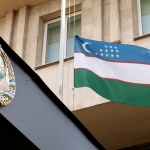16 AUGUST 2019 Y.
Mysteries and Discoveries
There is one more evidence that Zoroastrianism and Nestorianism were existing peacefully side by side that is a pattern in architecture called “Zoroastrianism Butterfly” that reminds Nestorian cross.
On the other side of Djeykhun (which was separating two settlements in the ancient times) there is Guyar-Kala, 4-2 centuries B.C., or also called the Fortress of Unfaithful. It got this name after Arab invasion – for a long time, local people were resisting new religion being loyal to Zoroastrianism. Today these are picturesque ruins, natural sculptures carved by wind and time.
Djeykhun was flowing at the foot of another fortress – Toprak-Kala, a place of kings’ burial. Once there was a ladder leading to its flat top. Bodies of passed away people were brought to fortress’ foot along the river – it used to be a procession with torches, – then put on the top of it so that according to Zoroastrianism traditions their bodies were pecked by birds, then their bones were carefully put into assuariy and buried. At this place exactly, remains of brick patterns displaying sun rays were found which gave a hint to scholars about Sun cult in this region and about peculiar dialogue between God and people. After the Arab invasion, Toprak-Kala served as a signal tower.
Of course, ancient Khoresm people were not only creating myths but were good economic managers and entrepreneurs. In Mizdakhan there is Caravan-Saray named Mazlum-Sulu which is unique in its own way. The talented architect took climate peculiarities into consideration and constructed a building going down into the ground. Through a small window on its ceiling light can get inside almost during the whole light day, during cold winters there is warm while during hot summer it is quite cool. There are accommodation and storage sections as well as vast commonplace. People found out that it was a caravan-saray but not mausoleum only in 1930th. It used to be a mausoleum during Chingizkhan invasion – he burnt the land and trade stopped, caravan-sarays were empty and became mausoleums. As ancient historians say, architecture tells us about history better than man. When a country prospers, people build caravan-sarays and madrassas. During troubled times, mausoleums appear.

Archeologists dug a tombstone in this mausoleum-caravan-saray, under which there were tree people buried. One of them was a woman – a magishe, according to the inscription. This Indian term means “princess’ servant” who helped the princess to dress and comb hair.
Of course, there is a legend about this place. People say that this is a burial place of servants and two beloved ones – a princess and an architect. To prove his love, beauty asked a young man to build a palace for her and to jump from its highest tower. Probably, it was a joke. Yet, the architect jumped and was killed. Being afraid of the consequences, the princess jumped from the tower as well. This place is enclosed by ribbons and is a pilgrimage place for all lovers. Possibly, it is a reminder to all of them that there is no need to make jokes with love.
There are more than 300 ancient monuments and each of them is covered with legend and amazing scientific discovery. Karakalpakia is a land of many mysteries.
The most important things are to be able to see, readiness for adventures and good guide. And this trip will be unforgettable.














